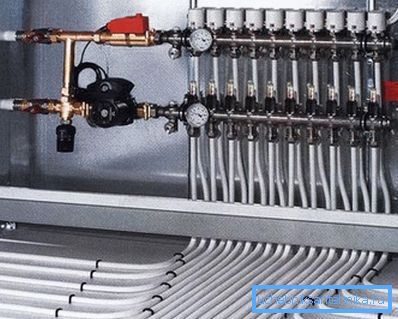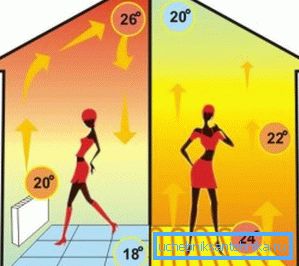What is better radiators or underfloor heating: materials
The radiator heating system of housing has existed for more than a hundred years, it has been tested many times and is very reliable. The warm floor has become widespread relatively recently, but the manufacturers of this innovation speak of its absolute advantage over batteries. As usual, the answer lies somewhere in the middle, so now we will try to compare the warm floor and radiator heating, from the point of view of independent experts.

Important: in many megalopolises of our great power, including in Moscow, it is officially forbidden to install a liquid floor heating system in multi-storey buildings with central heating. The only option in this case is a combined heating radiators plus a warm floor, but only with electric heating.
First about the economy
The question that the floor heating or radiator is more economical is not immediately and unambiguously answered. This problem consists of two components. The first is the cost of purchasing equipment and installation directly. The second, but no less important side, is the cost of fuel in the long term.

Important: heated coatings can be liquid and electric. The electric version is often quite expensive, so we will continue to consider only water systems.

Materials and installation work
Before you choose a warm floor or radiator, let's take a look at the basic stages of installation.
In this case, it is not so important whether you install everything yourself or entrust the professionals to buy the materials anyway.
- To begin with, when installing underfloor heating, the level of finishing coverage will rise by an average of 60 - 100 mm. If in a private house it usually does not cause problems, then in a city apartment this fact often becomes the main stumbling block. While there are no significant limitations when installing batteries.

- The heating coating in most cases is placed on a completely flat concrete base.. For this, a layer of roll-up waterproofing is made up with entry onto the walls and a layer of thermal insulation so as not to heat the concrete in vain.
- Any material expands slightly when heated.. To prevent future cracking, a damper tape made of polyethylene foam or other porous material is glued around the perimeter of the room.

- Metalplastic or copper pipes are used for such systems.. Of course, it is cheaper to fasten a snake with clamps to a metal grid. But it is much more convenient and safer to use a special "carpet" with round bosses. The laying step ranges from 10 to 35 cm, and the gap between the wall and the snake is at least 7 cm.

- After connecting and crimping, experts recommend pouring a self-leveling screed, but in the case of mounting, you can lay a layer of foamed polyethylene on a special carpet and immediately lay the laminate.
As for the installation of traditional batteries, the instruction is much simpler, and most importantly cheaper.
- The batteries themselves will cost the most. In the accessible sector, the palm is held by old proven cast-iron radiators of the MS-140 type. The price of aluminum products is also low, but they are suitable only for a private house and not everywhere. The elite are bimetallic structures or art cast iron.

- Polypropylene pipes to connect the radiator system, have an acceptable cost, plus they are quite simple to assemble. For open wiring there are brackets that are attached to the wall with anchor bolts. And under the hidden installation the strobe is cut through, after which the pipe is laid in and smeared into it.
- Essentially, the most significant costs are in batteries and pipes., fittings, brackets and other accessories are inexpensive.
As you can see, a heated floor instead of radiators is incomparably more problematic to mount and several times more expensive. It is possible to drive several brackets into the wall, hang a battery on them and connect it in a few hours. While the warm floor technology keeps within several days.

Fuel costs
Experts say that heating under floor heating without radiators is much more profitable in the long run. After all, the temperature of the coolant in the floor system on average is kept at 40? С, the maximum does not exceed 60? С.
In this range, not only gas or electric boilers can be used, but also solar collectors, heat pumps and condensing boilers. Which is much cheaper than traditional fuel.

Since the square of the floor is disproportionately larger than the area of even the most voluminous battery, the heat output here will be slightly higher. With a lower indoor temperature, it is possible to achieve an optimum level of comfort. This leads to the fact that with proper installation, fuel savings can reach 12%.
According to the SNiP, the temperature of the water in the radiator system should be kept around 70? С. If we compare the warm floors or radiators in a private house, the first win significantly. After all, the price for a cubic meter of gas is constantly growing, and if you warm the house well, you can significantly reduce costs.

Important: of course, the coolant in the batteries may be lower in temperature, but in this case it will be necessary to increase the number of sections, which entails additional costs.
Important stuff
When choosing a warm floor or radiators, you should take into account the important feature of floor heating. The share of thermal radiation here reaches 70%, while convection leaves no more than 30%.
The batteries are exactly the opposite. A maximum of 15% is thermal radiation and up to 90% is due to convection. And according to doctors, radiant energy is better perceived by man.
Traditional batteries, no matter how beautiful and compact they are, occupy part of the living space. In this regard, warm floor with radiators do not compare, filled with screed or other coating pipes do not interfere with anyone.

But heating by warm floors without radiators, carries a lot of dangers. Furniture in such rooms because of the constant heating from the bottom, it is desirable to install only natural, and with high legs. Laminated chipboard, MDF, plastic and other “gifts” of civilization will fill the room with not the most useful fumes. Carpets are also contraindicated here.
Heat evenly coming from below lowers the humidity of the air by at least 20%. If you completely reject the batteries, then you will need to install separate humidifiers, as in our climate, to constantly keep the vent on airing is unrealistic. Otherwise, you and your household are provided with malaise and headaches.
Of course, drafts with floor heating in your home will not. Manufacturers say that a gradual decrease in temperature from the floor to the ceiling contributes to a comfortable microclimate.
But doctors say that it is contraindicated for hypertensive patients, people with allergies, asthmatics and people with varicose veins. Children are also not recommended constant heating from below.

Golden mean
We have listed only the main advantages and disadvantages of these two areas; in the video in this article, the experts reveal a lot more subtleties. As can be seen from the above, the ideal solution is a combined heating system: radiators and heated floor. With the right approach, you can optimally combine these two systems.
Heating with floor heating and radiators, where floor heating is used in the kitchen, hall and services, while the batteries are installed in all other rooms, is deservedly considered optimal. With this approach, the increased humidity in the kitchen and services will be compensated by the lower heating. And the hall will receive a continuous thermal veil.

Important: the scheme is a heated floor plus radiators, it must necessarily include in its composition thermomixers. The thing is that in cold weather there is hot water on the radiators, if it is allowed into the system of warm floors, it will be impossible to walk on them. Thermomixers will regulate the temperature balance in different sectors.
Conclusion
The durability of both systems separately, and combined together, directly depends on the quality of materials and professional installation. If you do not save on the main bearing nodes, then even the heating collected by yourself will work for at least 30-40 years. Reputable companies specializing in the installation of heating, give a guarantee of 50 years.
